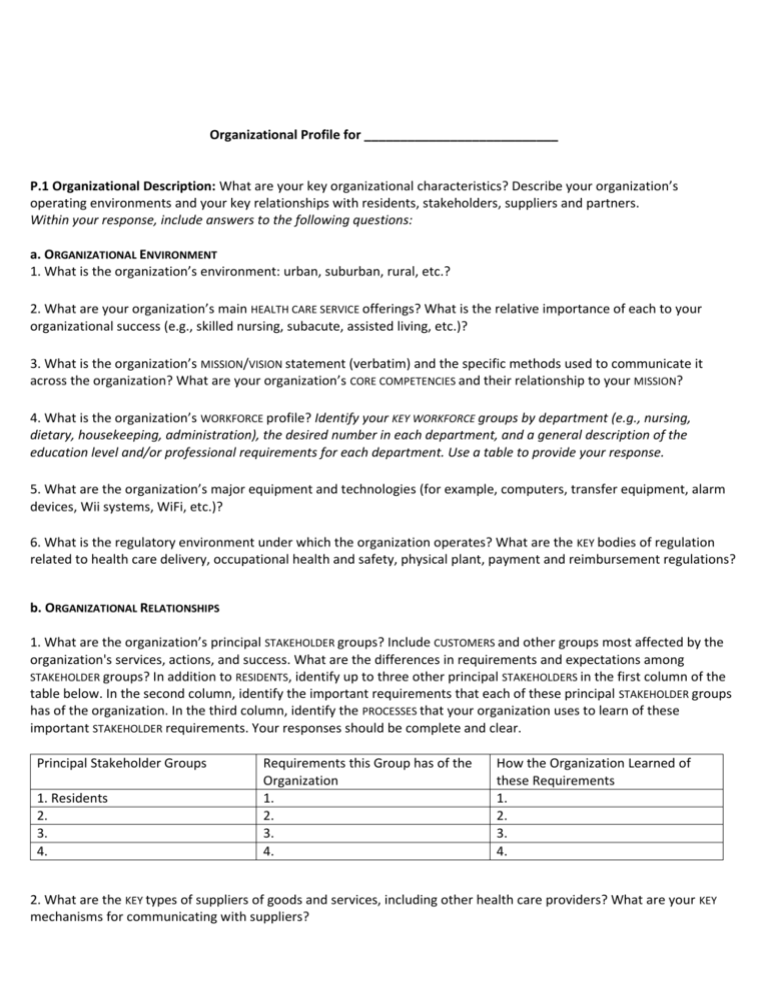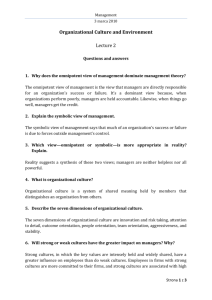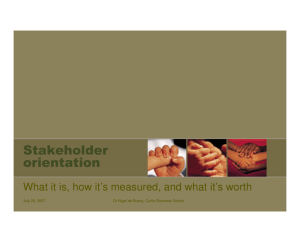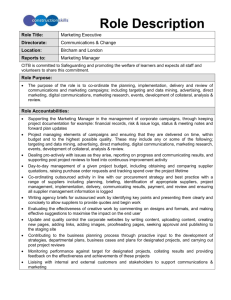Organizational assessment Word Template (00710298)
advertisement

Organizational Profile for ___________________________ P.1 Organizational Description: What are your key organizational characteristics? Describe your organization’s operating environments and your key relationships with residents, stakeholders, suppliers and partners. Within your response, include answers to the following questions: a. ORGANIZATIONAL ENVIRONMENT 1. What is the organization’s environment: urban, suburban, rural, etc.? 2. What are your organization’s main HEALTH CARE SERVICE offerings? What is the relative importance of each to your organizational success (e.g., skilled nursing, subacute, assisted living, etc.)? 3. What is the organization’s MISSION/VISION statement (verbatim) and the specific methods used to communicate it across the organization? What are your organization’s CORE COMPETENCIES and their relationship to your MISSION? 4. What is the organization’s WORKFORCE profile? Identify your KEY WORKFORCE groups by department (e.g., nursing, dietary, housekeeping, administration), the desired number in each department, and a general description of the education level and/or professional requirements for each department. Use a table to provide your response. 5. What are the organization’s major equipment and technologies (for example, computers, transfer equipment, alarm devices, Wii systems, WiFi, etc.)? 6. What is the regulatory environment under which the organization operates? What are the KEY bodies of regulation related to health care delivery, occupational health and safety, physical plant, payment and reimbursement regulations? b. ORGANIZATIONAL RELATIONSHIPS 1. What are the organization’s principal STAKEHOLDER groups? Include CUSTOMERS and other groups most affected by the organization's services, actions, and success. What are the differences in requirements and expectations among STAKEHOLDER groups? In addition to RESIDENTS, identify up to three other principal STAKEHOLDERS in the first column of the table below. In the second column, identify the important requirements that each of these principal STAKEHOLDER groups has of the organization. In the third column, identify the PROCESSES that your organization uses to learn of these important STAKEHOLDER requirements. Your responses should be complete and clear. Principal Stakeholder Groups 1. Residents 2. 3. 4. Requirements this Group has of the Organization 1. 2. 3. 4. How the Organization Learned of these Requirements 1. 2. 3. 4. 2. What are the KEY types of suppliers of goods and services, including other health care providers? What are your KEY mechanisms for communicating with suppliers? 3. From the above, what are the most important types of suppliers of goods and services? 4. What are the limitations, special business relationships, or special requirements that may exist with some or all suppliers and partners? 5. What are the organizational structures and KEY management links to the parent company if the applicant organization is owned by a parent organization? Respond “NA” if the applicant is not owned by a parent organization. P.2 Organizational Situation: What is your organization’s strategic situation? Describe your organization’s competitive environment, key strategic challenges and advantages, and your system for performance improvement. Within your response, include answers to the following questions: a. COMPETITIVE ENVIRONMENT 1. What is the organization’s position (relative size) within the local market environment? Include numbers and types of competitors. 2. What are the principal factors that determine competitive success in the local market? 3. What are your key available sources of competitive and COMPARATIVE DATA from within the long term care profession? What limitations, if any, are there in your ability to obtain this data? b. STRATEGIC CONTEXT 1. What are at least two major STRATEGIC CHALLENGES or ADVANTAGES for the organization (e.g., entry into new markets or SEGMENTS, relationships or partnerships with Preferred Provider Networks, preparing for different expectations of the next generation of residents, human resource recruitment and retention, new alliances with suppliers, physicians, or other partners, introduction of new technologies, changes in the health care environment that impact the organization’s delivery of services, changes in strategy, or other challenges or advantages)? 2. What is the reason(s) why it is important that the organization address these STRATEGIC CHALLENGES or ADVANTAGES?











